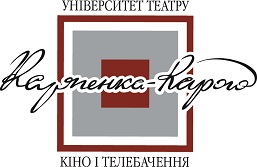Естетика кліпу у сучасному соціокультурному просторі
DOI:
https://doi.org/10.34026/1997-4264.22.2018.217071Ключові слова:
кліп, медіа-, культура, символ, образ, кліпове мисленняАнотація
У статті в соціокультурному аспекті розглянуто основні етапи формування кліпу як медіа-форми, вплив його символічних образів і фрагментарної структури на сучасний спосіб мислення та світосприйняття.
Посилання
Baudrillard, J. (2013). Simulacra and Simulation. (O. Pechenkina, Trans). – Tula : Tulskiy Poligrafist, 204 [in Russian].
Baudrillard, J. (2001). The System of Objects. (S. Zenkina, Trans). – Moscow : Rudomino, 218 [in Russian].
Husserl, Ed. (1994). Vol. I. On the Phenomenology of the Consciousness of Internal Time. (V. Molchanova, Trans). – Moscow : Gnozis, 162 [in Russian].
Husserl, Ed. (2001). Collected works. Vol. III (1). Logical Investigations. Vol. II (1). Studies on phenomenology and theory of knowledge. (V. Molchanova, Trans). – Moscow : Gnozis, Dom intellektualnoy knigi, 576 [in Russian].
Guy-Ernest Debord. The Society of the Spectacle. – https://avtonom.org/old/lib/theory/debord/society_of_spectacle.htm.
Dery, M. (2008). Escape Velocity: Cyberculture at the End of the Century. (T. Parfenova, Trans). – Ekb : U-Faktoriya, 480 [in Russian].
Sergei Eisenstein. Behind frame. – URL: http://www.metaphor.narod.ru/eizenstein_beyond.htm
Cassirer, E. (1998). Favorites. Experience of man: an introduction to the philosophy of human culture. (A. Muravev, Trans). – Moscow : Gardariki, 784 [in Russian].
Castells, M. (2000). The Information Age: Economy, Society and Culture. (O. Shkaratan, Trans). – Moscow : GU VshE, 608 [in Russian].
Kirillova, N. (2005). Media-culture: from the modern to the postmodern. – Moscow : Academic Project, 448 [in Russian].
Lacan, J. (2004). Seminars. Book 11. The Four Fundamental Concepts of Psychoanalysis. (A. Chernoglazova, Trans). – Moscow : Logos, 304 [in Russian].
Emelyanenko, V. (2013). The man of the future – opinion of the futurologist. – URL: http://fant-usas.at.ua/publ/chelovek_budushhego_mnenie_futurologa/1-1-0-242.
McLuhan, M. (2007). Understanding Media: The Extensions of Man. (V. Nikolaeva, Trans). – Moscow: Giperboreya, 464 [in Russian].
Mankovskaya, N. (2000). Aesthetics of Postmodernism. – St. Petersburg : Alateyіa, 347 [in Russian].
Naydiva, L. & Barshpilts, O. (Eds.). (2009). Media culture of the person: socio-psychological approach. – Kiev : Millennium, 440 [in Ukrainian].
Granovskaya Rada. (2015). People with clip-like thinking will not become elite. – URL: http://doctor.kz/health/news/2015/04/07/17216.
Rushkoff, D. (2003). Media Virus: Hidden Agendas in Popular Culture. (D. Borisov, Trans). – Moscow: Ultra Culture, 358 [in Russian].
Sadoul, G. (1957) The history of cinema from its inception to our days. (M. Levin, Trans). – M. : Inlitizdat, 313 [in Russian].
Warhol, A. & Hackett. P. (2012). POPism: The Warhol Sixties. (L. Rechnaya, Trans). – Saint Petersburg: Amphora, 350 [in Russian].
Yampolskiy, M. (Eds.) (1988). From the history of the French motion picture: Silent cinema 1911-1933. (S. Yutkevich, Trans). – Moscow: Iskusstvo, 317 [in Russian].
##submission.downloads##
Опубліковано
Номер
Розділ
Ліцензія
Автори, подають наукові статті для публікації у «Науковому Віснику» на таких умовах:
а) Автори, подаючи наукові статті для публікації, надають збірнику «Науковий Вісник» право першої публікації (за ліцензією Creative Commons Attribution). Це дає змогу іншим ділитися роботою з підтвердженням авторства роботи та первинної публікації в цьому збірнику. Водночас за авторами зберігаються в повному обсязі авторські права, що підтверджується Законом України про авторське право і суміжні права за № 3702-ХІІ від 23.12.1993 р.;
б) Автори мають право укладати додаткові окремі угоди на договірній основі стосовно невиключного поширення опублікованої версії Збірника (публікації в книжці, інституційному сховищі тощо), з підтвердженням початкової публікації в цьому виданні;
в) Автори також мають право розмістити свої праці в мережі Інтернет (на їх веб-сайті чи в іниституційних сховищах) до подання чи під час подання праць на розгляд редакційної ради Збірника.
ЛІЦЕНЗІЙНІ УМОВИ
За авторами збірника наукових праць «Науковий Вісник Київського національного університету театру, кіно і телебачення ім. І.К. Карпенка-Карого» / «Naukovij vìsnik Kiïvskogo nacìonalnogo unìversitetu teatru, kìno ì telebačennâ ìm. Ì.K. Karpenka-Karogo» зберігається авторське право що підтверджується Законом України про авторське право і суміжні права за № 3702-ХІІ від 23.12.1993 р. (остання поточна редакція 14.10.2020). За ліцензійними умовами надається право також і редакції збірника публікувати оригінальні наукові статті, що містять нові наукові дослідження й не публікувалися в інших виданнях.
Ліцензійна політика журналу сумісна з переважною більшістю політик відкритого доступу та архівування матеріалів. Всі матеріали поширюється на умовах ліцензії Creative Commons Attribution 4.0 International License, яка дозволяє іншим розповсюджувати роботу з визнанням авторства цієї роботи і першої публікації в цьому журналі. Автор зберігає авторські права і права на публікацію без обмежень.
Погляди авторів публікацій можуть не збігатися з поглядами редакції. За достовірність фактів, дат, прізвищ тощо відповідальність несуть автори.









